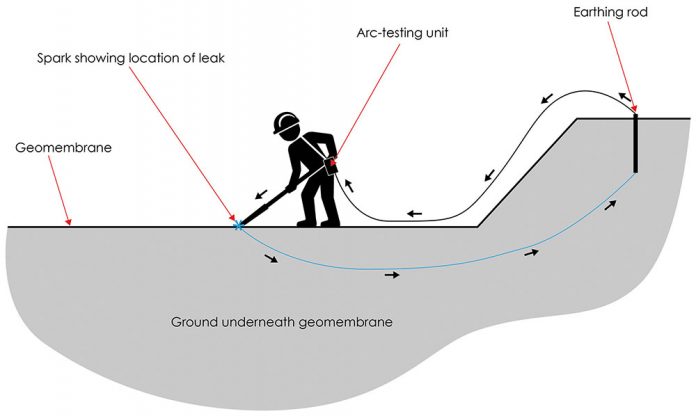The use of polymer barrier layers for groundwater leachate prevention, and capping has been common since the 1970’s. Most installations are HDPE-based, although other materials are used.
The performance of these membranes is generally excellent, but they are sensitive to poor installation and to abuse or accidental damage during their service life. Even a tiny hole can easily exceed the permeation rate of a hectare of membrane, so it is imperative that the membrane integrity is assured at handover.
The key risk areas during installation are weld failure and damage which may occur through poor preparation, incorrect settings, contamination, wrinkling, machinery movements, or wind uplift.
The key quality control technique recommended by the Environment Agency LFE5 is the use of double welded lap joints, which are proven by conducting an air pressure test on the enclosed volume between the welds. The use of electronic testing is also referred to in this document, particularly ASTM D6365, and “further integrity tests” however, there are few details.
Electronic leak detection is not a new technique, but has been applied in industry for at least a century. Testing is only suitable for non-conductive layers, so materials such as EPDM can be problematic, however the majority of the membranes in current use are suitable. The basis of the test methods is that a hole in an insulating membrane will allow an electric current to pass, and this current can be detected directly, or its effect on an electric field can be detected, by purpose-made instruments, which alert the user to the presence of even tiny flaws in the membrane. With careful use by skilled operators, holes of well under 1mm can be found and located accurately.
Test instruments may use low voltages (generally 32V, though other voltages are used), or voltages sufficiently high to generate a spark in air, typically 1kV (1000V) and above.
Buckleys (UVRAL) Ltd., has been the leading British manufacturer of electronic holiday detectors for many years – we will celebrate our centenary in 2026. Our products are designed, developed, and manufactured in-house, in our facility in Kent, and are used in construction, manufacturing, the oil industry and healthcare around the world.
In low voltage testing the current must pass through a conductive medium – water – which is applied to the membrane and the instrument is used to detect the current flowing through the leak. This technique is described in an ASTM specification, D7877 as “low voltage vector mapping”. Whilst the Buckleys Wet Roof Pro’ can be used for testing geomembranes, this technique is generally more appropriate when surveying roofing membranes.
Turning to high voltage testing, the ASTM specification, D6365, referred to above is entitled “Standard practice for the non-destructive testing of geomembrane seams using the spark test”. A closely related approach is detailed in ASTM specification, D7953, entitled “Standard practice for electrical leak location on exposed geomembranes using the arc testing method”. The Buckleys Geo Pro’ instrument is appropriate for both.
In the first case, the apparatus is connected to a grounding wire embedded within the weld itself, whereas in the second, it is connected to a grounding pin, inserted into the earth outside the membrane border. The instrument generates a user-set voltage to the electrode, which the user then brushes over the area to be tested. If there is a pinhole or flaw in the membrane, the instrument will detect the current between the probe and the ground and raise an alarm if this exceeds the pre-determined threshold.
This technique is very commonly applied around the world to geomembrane, roofing membrane and other waterproofing applications. With careful operators, and moderate, easily learned skills, it is possible to pinpoint a leak very quickly using these techniques. Significant areas can be covered too – using a Geo Pro’ with a 450mm brush a single operator can reliably test an area of exceeding 2000m2 per day.
If an inadequate voltage is used, then the instrument will simply not “see” the flaw. Buckleys instruments can output 40kV which exceeds the requirements of any of the standards, but which, when testing highly resistant materials, gives the inspection team confidence that nothing has been missed.
Buckleys high Voltage instruments are designed with a standard interface, which means that a variety of electrodes and probes can be used, in order to ease the task of the inspector. When testing geomembranes, we recommend a bronze-bristle brush of 450mm width, with appropriate extension rods, a seam probe electrode and “drum brush” to cover the needs.
If you would like more information about Buckleys electronic leak detection systems, or a Covid-safe demonstration of their versatility and capability, please contact:
sales@buckleys.co.uk
+44 (0) 1303 278 888
www.buckleysinternational.com



